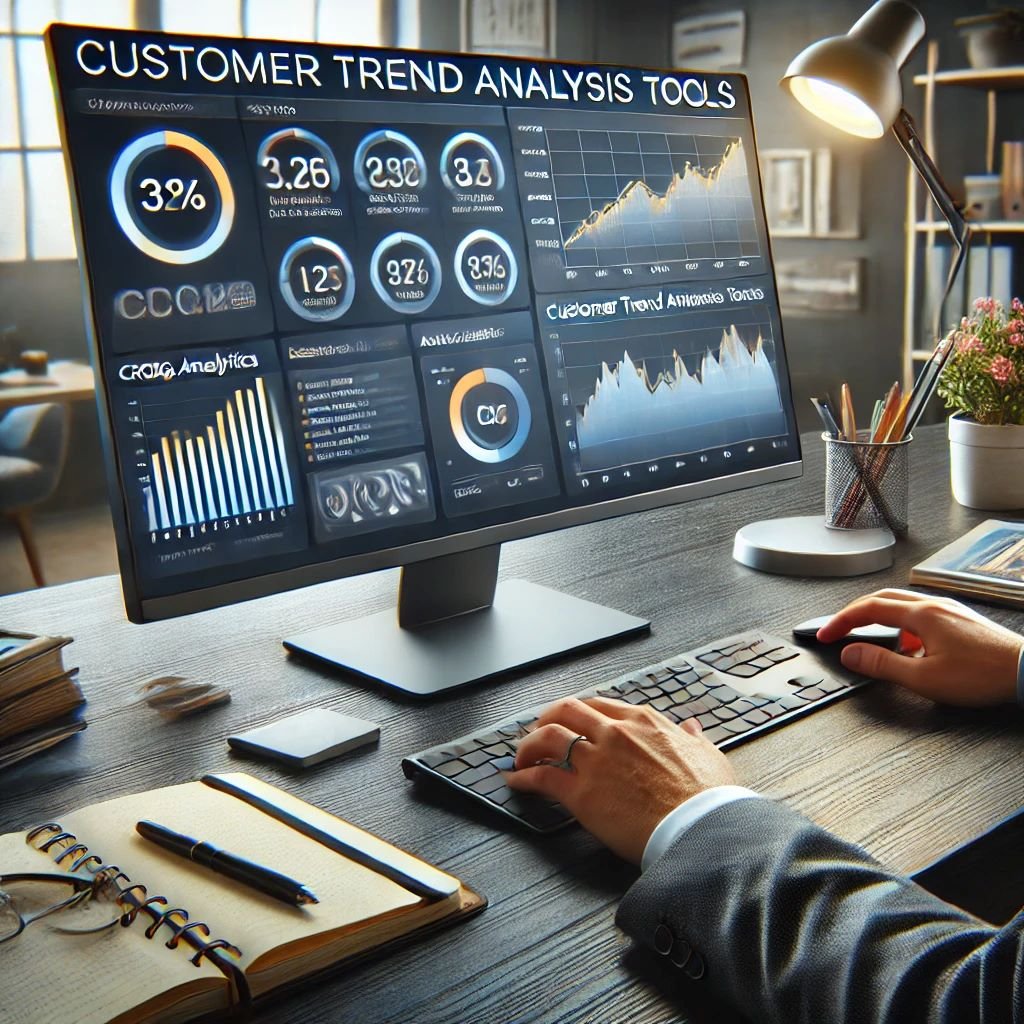
Tools for Customer Trend Analysis: A Comprehensive Report
Introduction
Customer trend analysis is a crucial aspect of modern business strategy, enabling companies to understand customer behavior, preferences, and needs.
By leveraging advanced tools, businesses can gather, analyze, and interpret data to uncover trends that inform decision-making and strategy development.
This report explores the essential tools for customer trend analysis, focusing on Customer Relationship Management (CRM) systems and analytical tools such as Google Analytics and Business Intelligence (BI) tools.
Customer Relationship Management (CRM) Systems
Customer Relationship Management (CRM) systems are vital tools for managing interactions with current and potential customers.
These systems help businesses build and maintain strong relationships by centralizing customer data and providing insights into customer behavior.
1. Overview of CRM Systems
CRM systems are designed to streamline and automate various customer-related processes, from sales and marketing to customer service.
By consolidating customer information into a single database, CRMs provide a comprehensive view of each customer’s journey, enabling businesses to track interactions, manage sales pipelines, and personalize marketing efforts.
2. Key Features of CRM Systems
a. Data Management
CRM systems centralize customer data, including contact details, purchase history, communication records, and preferences.
This comprehensive data management enables businesses to:
- Maintain Accurate Customer Records: Keep all customer information up-to-date and easily accessible.
- Track Customer Interactions: Monitor interactions across various channels (email, phone, social media) to ensure consistent communication.
- Segment Customers: Group customers based on shared characteristics, such as demographics, behavior, or purchasing history, to tailor marketing efforts.
b. Sales and Pipeline Management
CRM systems help businesses manage their sales pipelines by tracking leads, opportunities, and deals. Key features include:
- Lead Tracking: Monitor the progress of leads through the sales funnel, from initial contact to conversion.
- Opportunity Management: Track potential deals and forecast revenue based on the likelihood of closing.
- Sales Reporting: Generate reports on sales performance, identifying top-performing products, sales reps, and strategies.
c. Marketing Automation
CRM systems often include marketing automation features that enable businesses to automate repetitive marketing tasks, such as email campaigns, social media posting, and customer segmentation.
Benefits include:
- Personalized Marketing: Deliver targeted marketing messages based on customer behavior and preferences.
- Automated Campaigns: Schedule and automate email campaigns, track open rates, and measure the effectiveness of marketing efforts.
- Lead Scoring: Automatically score leads based on their interactions with the brand, helping sales teams prioritize their efforts.
d. Customer Service and Support
CRM systems provide tools for managing customer service and support interactions, ensuring timely and effective resolution of customer issues. Features include:
- Ticketing Systems: Track customer inquiries and support tickets from submission to resolution.
- Knowledge Bases: Create and maintain a centralized repository of FAQs, guides, and support articles.
- Customer Feedback: Collect and analyze customer feedback to identify areas for improvement and enhance the customer experience.
3. Popular CRM Systems
a. Salesforce
Salesforce is one of the most widely used CRM systems, offering a robust platform for managing customer relationships, sales, and marketing efforts.
Key features include:
- Sales Cloud: Tools for managing leads, opportunities, and sales pipelines.
- Marketing Cloud: Advanced marketing automation and analytics tools.
- Service Cloud: Comprehensive customer service and support features.
- Einstein Analytics: AI-powered analytics and predictive insights.
b. HubSpot CRM
HubSpot CRM is a popular choice for small to medium-sized businesses, offering a user-friendly interface and a range of features to manage customer relationships.
Key features include:
- Contact Management: Centralized database for managing customer information.
- Email Marketing: Tools for creating and automating email campaigns.
- Sales Automation: Pipeline management and lead tracking tools.
- Integration: Seamless integration with HubSpot’s marketing, sales, and service hubs.
c. Zoho CRM
Zoho CRM is a versatile platform that offers a range of features for managing customer relationships, sales, and marketing. Key features include:
- Multichannel Communication: Tools for managing interactions across email, phone, social media, and live chat.
- Sales Automation: Workflow automation, lead scoring, and sales forecasting.
- Customization: Highly customizable interface and workflows to meet specific business needs.
- Analytics and Reporting: Advanced analytics and reporting tools for tracking performance and identifying trends.
Analytical Tools for Customer Trend Analysis
Analytical tools are essential for analyzing customer data, identifying trends, and generating actionable insights.
These tools enable businesses to delve deeper into customer behavior, track key metrics, and make data-driven decisions.
1. Google Analytics
Google Analytics is a powerful web analytics tool that provides insights into website traffic, user behavior, and marketing effectiveness.
It is widely used for tracking and analyzing customer interactions with websites and online content.
a. Key Features of Google Analytics
- Audience Insights: Understand the demographics, interests, and behavior of website visitors.
- Acquisition Reports: Track the sources of website traffic, such as search engines, social media, and referral sites.
- Behavior Analysis: Monitor how users interact with the website, including page views, time on site, and bounce rates.
- Conversion Tracking: Measure the effectiveness of marketing campaigns by tracking conversions, such as form submissions, purchases, and downloads.
- E-commerce Tracking: Analyze online sales performance, including product performance, average order value, and shopping behavior.
b. Google Analytics 4 (GA4)
Google Analytics 4 is the latest version of Google Analytics, offering enhanced features for cross-platform tracking, event-based data collection, and advanced AI-driven insights.
Key enhancements include:
- Cross-Device Tracking: Track user interactions across multiple devices and platforms, providing a unified view of the customer journey.
- Event-Based Data Model: Focus on specific user actions (events) rather than page views, allowing for more detailed analysis of user behavior.
- Predictive Analytics: AI-powered insights and predictions, such as purchase probability and churn likelihood.
2. Business Intelligence (BI) Tools
Business Intelligence (BI) tools are designed to transform raw data into meaningful insights through data visualization, reporting, and advanced analytics.
These tools are essential for analyzing large datasets and identifying trends in customer behavior.
a. Key Features of BI Tools
- Data Integration: Connect and consolidate data from multiple sources, such as CRM systems, databases, and marketing platforms.
- Interactive Dashboards: Create dynamic visualizations, such as charts, graphs, and tables, to explore and analyze data.
- Advanced Analytics: Use machine learning, predictive modeling, and statistical analysis to uncover patterns and trends.
- Reporting and Collaboration: Generate reports, share insights, and collaborate with team members to drive informed decision-making.
b. Popular BI Tools
i. Tableau
Tableau is a leading BI tool known for its powerful data visualization capabilities.
It allows users to create interactive dashboards and explore data through intuitive drag-and-drop functionality. Key features include:
- Visual Analytics: Create detailed visualizations to explore data and identify trends.
- Data Connectivity: Connect to various data sources, including cloud services, databases, and spreadsheets.
- Tableau Prep: Tools for data preparation, cleaning, and transformation.
- Collaboration: Share dashboards and insights with team members and stakeholders.
ii. Power BI
Power BI is Microsoft’s BI tool, offering robust data analysis and visualization capabilities. It is widely used for creating reports, dashboards, and data models.
Key features include:
- Data Connectivity: Connect to a wide range of data sources, including Microsoft Excel, SQL Server, and cloud services.
- Interactive Visualizations: Create dynamic reports and dashboards with drill-down capabilities.
- Power BI Desktop: Tools for data preparation, modeling, and visualization.
- Integration: Seamless integration with other Microsoft products, such as Excel, Azure, and Teams.
iii. Qlik Sense
Qlik Sense is a BI tool known for its associative data indexing, which allows users to explore data from multiple perspectives.
It is designed for self-service analytics and data discovery. Key features include:
- Associative Data Model: Explore data from various angles and uncover hidden relationships.
- Interactive Dashboards: Create visualizations that update in real-time as users interact with the data.
- Advanced Analytics: Tools for predictive analytics, machine learning, and data storytelling.
- Collaboration: Share insights and collaborate with team members through Qlik Sense’s cloud-based platform.
Benefits of Using CRM and Analytical Tools for Customer Trend Analysis
1. Enhanced Customer Insights
CRM and analytical tools provide deep insights into customer behavior, preferences, and trends.
By analyzing customer data, businesses can understand their customers better and tailor their strategies accordingly.
2. Improved Decision-Making
These tools enable data-driven decision-making by providing actionable insights.
Businesses can identify opportunities, mitigate risks, and optimize their marketing, sales, and customer service efforts.
3. Increased Efficiency
CRM and BI tools automate many data collection, analysis, and reporting processes, reducing manual effort and improving efficiency.
This allows businesses to focus on strategy and execution.
4. Personalization and Customer Experience
By leveraging customer data, businesses can create personalized experiences that resonate with their audience.
This enhances customer satisfaction, loyalty, and lifetime value.
5. Competitive Advantage
Businesses that effectively use CRM and analytical tools gain a competitive edge.
They can anticipate market trends, respond quickly to customer needs, and stay ahead of competitors.
Challenges and Considerations
1. Data Quality
The effectiveness of CRM and analytical tools depends on the quality of the underlying data.
Businesses must ensure their data is accurate, complete, and up-to-date to generate meaningful insights.
Poor data quality can lead to incorrect conclusions and misguided strategies.
2. Integration and Compatibility
Integrating CRM and analytical tools with existing systems can be challenging, especially if the tools are not compatible with the current technology stack.
Businesses must ensure seamless data flow between different platforms and systems to achieve comprehensive analysis.
3. Data Security and Privacy
Handling large volumes of customer data comes with significant security and privacy concerns.
Businesses must comply with data protection regulations such as GDPR and CCPA and implement robust security measures to protect sensitive customer information.
4. User Adoption and Training
For CRM and analytical tools to be effective, employees must be trained to use them properly.
User adoption can be a challenge if the tools are complex or if employees are resistant to change.
Ongoing training and support are essential to ensure that teams can fully leverage the capabilities of these tools.
5. Cost and ROI
The implementation and maintenance of CRM and analytical tools can be costly, particularly for small and medium-sized businesses.
It is crucial to assess the return on investment (ROI) and ensure that the benefits of using these tools outweigh the costs.
Conclusion
CRM systems and analytical tools are indispensable for customer trend analysis in today’s data-driven business environment.
These tools provide businesses with the insights needed to understand customer behavior, anticipate trends, and make informed decisions.
By leveraging CRM systems, businesses can manage customer relationships more effectively, while analytical tools like Google Analytics and BI platforms enable deeper analysis of customer data.
However, to maximize the benefits of these tools, businesses must address challenges related to data quality, integration, security, user adoption, and cost.
With the right approach, businesses can use CRM and analytical tools to enhance customer experiences, drive growth, and maintain a competitive edge in the market.
As customer expectations continue to evolve, the importance of using advanced tools for customer trend analysis will only increase.
Businesses that invest in these technologies and develop the expertise to use them effectively will be well-positioned to thrive in the increasingly competitive landscape.
Back to How to Use Data Analytics Main Page


